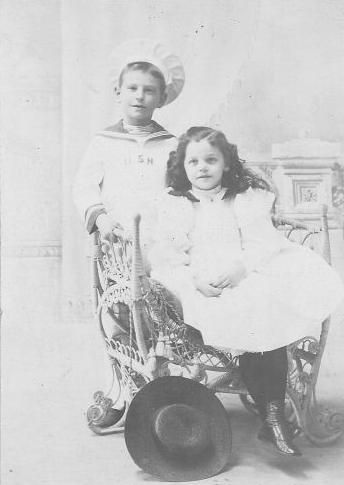
United States Children's Headwear: Gender Trends

Figure 1.--Here we see an unidentified brother and sister from a well-to-donfamily, we think at the turn-of-the 20th century , probably about 1900-05. (The clothes, mount style, and white whicker furniture help to date the cabinet portrait.) They look to be about 5-8 years old. The boy wears a white summer sailor suit with a saucer hat based on naval headweat at the time. His sister wears a voluminous white dress (we can't make out much detail) with black long stockings. Note her dark wide-brimmed sailor hat position so it can be seen at the foot of the chair. Younger boys also wore these hats, but girls did not wear sailor caps. The studio is Shipler in Clyde, New York.
|
|
There have been destinctive gender trends in headwear over time. Girls in the 19th centuyry mostly wore bonnets and hats. Sailor-styled hats became popular at mid-century. We occassionaly see girls wearing Scottish cpas, but this was not very commpn. Tams and berets began to become popular in the late 19th century. Only in the late-20th century do we see some girls wearing caps to any extent mostly baseball caos. We see Brownies (junior girl Scouts) wearing beanies in the mid-mid-20th centuty. Boys on the other hand wore both hats and caps. We note military-styled caps in the early-20th century. Rounded-crown hats were popular during the mid- and late-19th century. We notice boys after mid-century wearing both sailor hats and caps. Wide-brimmed sailor hats were worn by both boys and girls. At the turn-of-the 20th century we see boys wearing quite a range of different caps styles including the peaked-cap, and flat cap. The flat cap like corduroy knickers became a standard style by the 1910s. In the inter-War era in addition to flat caps we see beanies and boys from more affluent families wearing peaked caps.
During the War boys might wear swabie caps. At the mid-20th centrury we see some boys wearing fedora hats when dressing up. After mid-century headwear tended to go out of style, except the baseball cap and of course cold weather togs for winter. Boys might wear a variety of peaked caps, some times with earmuffs that can be pulled down
There have been destinctive gender trends in headwear over time. Girls very commonly wore headwear in the 19th century. Girls in the 19th centuyry mostly wore bonnets and hats. Sailor-styled hats became popular at mid-century. We occassionaly see girls wearing Scottish caps, but this was not very commpn. Tams and berets began to become popular in the late 19th century. Headwear became less common in the 20th century, especially the second half of the 20th century. We notice girls wearing a wide range of hats. The styles varies over time, but many styles were variation on sailor wide-brimmed hats. Age was less important than was the case for boys. We notice the most simple up to the rediculously elabotate. Hats could be large and elaborate in the late-19th and very early-20th centuty. Here there was a complication with hair stles as girls like to showcase their hair. There were also caps, but hats were more common. Some hats such as rounded-crown hats were similar to boys hsats, but the styles and decoration were mostly different. One style of caps worn by boys and girls were stocking caps. Often girls worn fancier stocking caps or caps of a different color , but often they wore the same styles as the boys. We notice girls of all ages wearing berets in the first half of the 20th century. Only very young boys wore berets. Only in the late-20th century do we see some girls wearing caps to any extent mostly baseball caos. We see Brownies (junior girl Scouts) wearing beanies in the mid-mid-20th centuty. oth boys and girls wore stocking caps with arange of gender differences.
Boys on the other hand wore both hats and caps. We note military-styled caps in the early-20th century. Rounded-crown hats were popular during the mid- and late-19th century. We notice boys after mid-century wearing both sailor hats and caps. Wide-brimmed sailor hats were worn by both boys and girls. At the turn-of-the 20th century we see boys wearing quite a range of different caps styles including the peaked-cap, and flat cap. The flat cap like corduroy knickers became a standard style by the 1910s. In the inter-War era in addition to flat caps we see beanies and boys from more affluent families wearing peaked caps.
During the War boys might wear swabie caps. At the mid-20th centrury we see some boys wearing fedora hats when dressing up. After mid-century headwear tended to go out of style, except the baseball cap and of course cold weather togs for winter. Boys might wear a variety of peaked caps, some times with earmuffs that can be pulled down. Both boys and girls wore stocking caps with arange of gender differences.
HBC

Navigate the Boys' Historical Clothing Web Site:
[Return to the Main U.S. headwear page]
[Return to the Main U.S. country garment page]
[Introduction]
[Activities]
[Biographies]
[Chronology]
[Clothing styles]
[Countries]
[Bibliographies]
[Contributions]
[FAQs]
[Glossary]
[Images]
[Links]
[Registration]
[Tools]
[Boys' Clothing Home]
Created: 11:44 AM 8/28/2013
Last updated: 11:44 AM 8/28/2013



